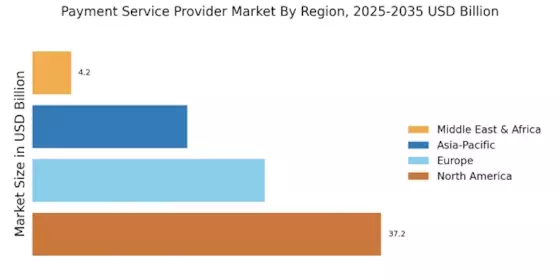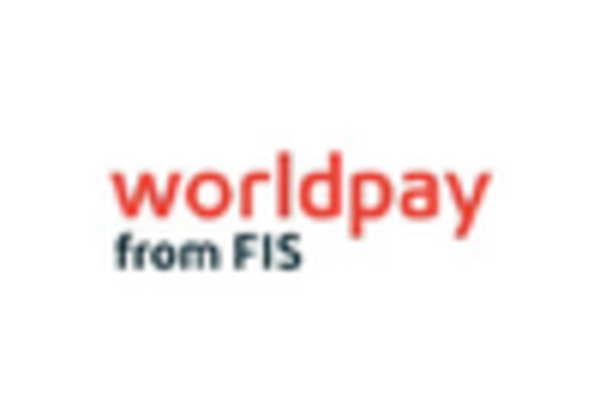Increasing E-commerce Adoption
The Payment Service Provider Market is experiencing a notable surge due to the increasing adoption of e-commerce platforms. As consumers increasingly prefer online shopping, businesses are compelled to enhance their payment processing capabilities. In 2025, e-commerce sales are projected to reach approximately 6 trillion USD, indicating a robust demand for efficient payment solutions. This trend necessitates that payment service providers offer seamless, secure, and diverse payment options to cater to a growing customer base. The integration of advanced technologies, such as digital wallets and contactless payments, further supports this shift, allowing consumers to transact effortlessly. Consequently, the Payment Service Provider Market is likely to expand as businesses seek reliable partners to facilitate their online transactions.
Focus on Enhanced Security Measures
The Payment Service Provider Market is increasingly focused on enhancing security measures to combat rising cyber threats. As digital transactions become more prevalent, the risk of fraud and data breaches escalates, prompting payment service providers to adopt robust security protocols. In 2025, the global market for payment security solutions is expected to grow significantly, reflecting the industry's commitment to safeguarding consumer data. This includes the implementation of advanced encryption technologies, multi-factor authentication, and real-time fraud detection systems. By prioritizing security, payment service providers not only protect their clients but also build trust with consumers, which is essential for sustaining growth in the Payment Service Provider Market.
Rising Demand for Cross-Border Transactions
The Payment Service Provider Market is witnessing a rising demand for cross-border transactions, driven by globalization and international trade. As businesses expand their reach beyond domestic markets, the need for efficient and cost-effective payment solutions becomes paramount. In 2025, cross-border e-commerce is projected to account for a significant portion of total e-commerce sales, highlighting the necessity for payment service providers to facilitate seamless international transactions. This trend encourages providers to develop multi-currency support and localized payment options, catering to diverse consumer preferences. Consequently, the Payment Service Provider Market is likely to experience growth as companies seek to navigate the complexities of cross-border payments.
Consumer Preference for Contactless Payments
The Payment Service Provider Market is increasingly influenced by consumer preferences for contactless payment methods. As consumers prioritize convenience and speed in their transactions, payment service providers are adapting to meet these expectations. In 2025, contactless payments are anticipated to represent a substantial share of total payment transactions, reflecting a shift in consumer behavior. This trend is further supported by the proliferation of mobile payment applications and digital wallets, which offer users a quick and secure way to pay. As a result, payment service providers are likely to invest in technologies that enhance contactless payment capabilities, thereby driving growth within the Payment Service Provider Market.
Technological Advancements in Payment Solutions
Technological advancements are significantly shaping the Payment Service Provider Market. Innovations such as blockchain technology, artificial intelligence, and machine learning are enhancing transaction security and efficiency. For instance, blockchain technology offers a decentralized approach to transactions, reducing fraud risks and increasing transparency. In 2025, the market for blockchain in payment processing is expected to grow substantially, reflecting the industry's shift towards more secure solutions. Additionally, AI-driven analytics enable payment providers to offer personalized services, improving customer satisfaction. As these technologies continue to evolve, they are likely to redefine the competitive landscape of the Payment Service Provider Market, compelling providers to adapt and innovate continuously.


















Leave a Comment